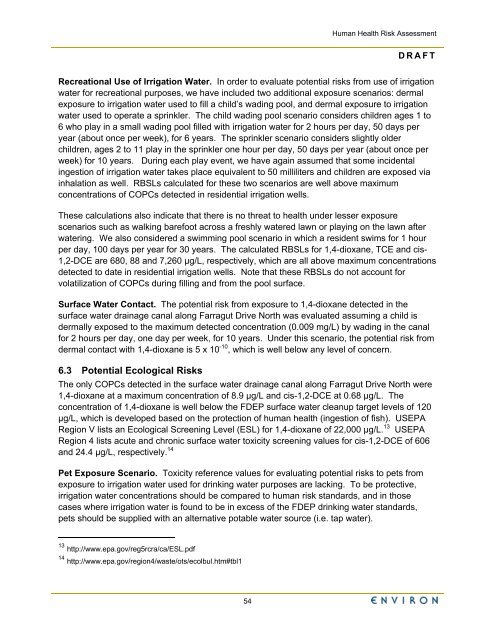Human Health Risk Assessment - Raytheon
Human Health Risk Assessment - Raytheon
Human Health Risk Assessment - Raytheon
Create successful ePaper yourself
Turn your PDF publications into a flip-book with our unique Google optimized e-Paper software.
54<br />
<strong>Human</strong> <strong>Health</strong> <strong>Risk</strong> <strong>Assessment</strong><br />
DRAFT<br />
Recreational Use of Irrigation Water. In order to evaluate potential risks from use of irrigation<br />
water for recreational purposes, we have included two additional exposure scenarios: dermal<br />
exposure to irrigation water used to fill a child’s wading pool, and dermal exposure to irrigation<br />
water used to operate a sprinkler. The child wading pool scenario considers children ages 1 to<br />
6 who play in a small wading pool filled with irrigation water for 2 hours per day, 50 days per<br />
year (about once per week), for 6 years. The sprinkler scenario considers slightly older<br />
children, ages 2 to 11 play in the sprinkler one hour per day, 50 days per year (about once per<br />
week) for 10 years. During each play event, we have again assumed that some incidental<br />
ingestion of irrigation water takes place equivalent to 50 milliliters and children are exposed via<br />
inhalation as well. RBSLs calculated for these two scenarios are well above maximum<br />
concentrations of COPCs detected in residential irrigation wells.<br />
These calculations also indicate that there is no threat to health under lesser exposure<br />
scenarios such as walking barefoot across a freshly watered lawn or playing on the lawn after<br />
watering. We also considered a swimming pool scenario in which a resident swims for 1 hour<br />
per day, 100 days per year for 30 years. The calculated RBSLs for 1,4-dioxane, TCE and cis-<br />
1,2-DCE are 680, 88 and 7,260 µg/L, respectively, which are all above maximum concentrations<br />
detected to date in residential irrigation wells. Note that these RBSLs do not account for<br />
volatilization of COPCs during filling and from the pool surface.<br />
Surface Water Contact. The potential risk from exposure to 1,4-dioxane detected in the<br />
surface water drainage canal along Farragut Drive North was evaluated assuming a child is<br />
dermally exposed to the maximum detected concentration (0.009 mg/L) by wading in the canal<br />
for 2 hours per day, one day per week, for 10 years. Under this scenario, the potential risk from<br />
dermal contact with 1,4-dioxane is 5 x 10 -10 , which is well below any level of concern.<br />
6.3 Potential Ecological <strong>Risk</strong>s<br />
The only COPCs detected in the surface water drainage canal along Farragut Drive North were<br />
1,4-dioxane at a maximum concentration of 8.9 µg/L and cis-1,2-DCE at 0.68 µg/L. The<br />
concentration of 1,4-dioxane is well below the FDEP surface water cleanup target levels of 120<br />
µg/L, which is developed based on the protection of human health (ingestion of fish). USEPA<br />
Region V lists an Ecological Screening Level (ESL) for 1,4-dioxane of 22,000 µg/L. 13 USEPA<br />
Region 4 lists acute and chronic surface water toxicity screening values for cis-1,2-DCE of 606<br />
and 24.4 µg/L, respectively. 14<br />
Pet Exposure Scenario. Toxicity reference values for evaluating potential risks to pets from<br />
exposure to irrigation water used for drinking water purposes are lacking. To be protective,<br />
irrigation water concentrations should be compared to human risk standards, and in those<br />
cases where irrigation water is found to be in excess of the FDEP drinking water standards,<br />
pets should be supplied with an alternative potable water source (i.e. tap water).<br />
13 http://www.epa.gov/reg5rcra/ca/ESL.pdf<br />
14 http://www.epa.gov/region4/waste/ots/ecolbul.htm#tbl1

















